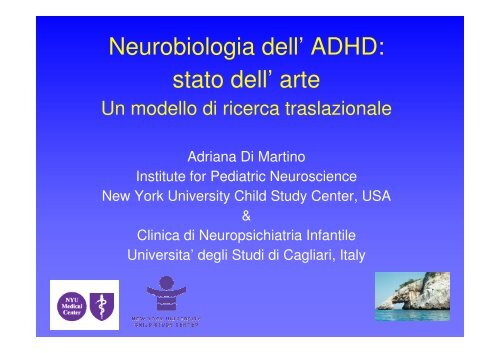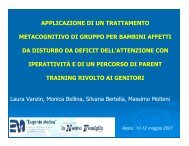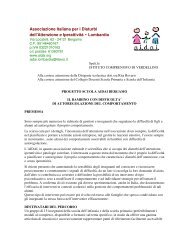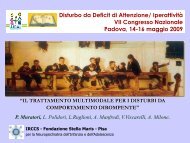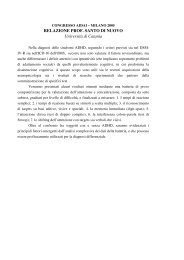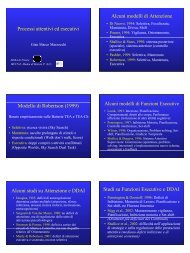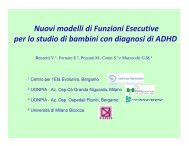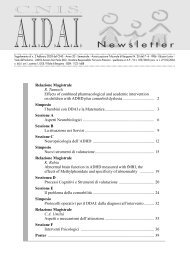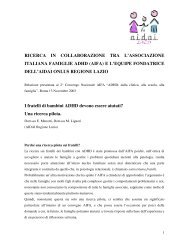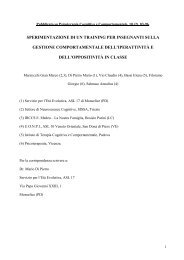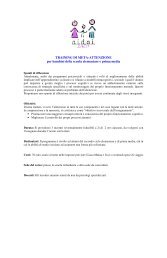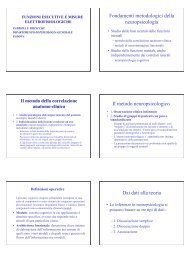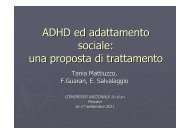Neurobiologia dell' ADHD: stato dell' arte - Aidai
Neurobiologia dell' ADHD: stato dell' arte - Aidai
Neurobiologia dell' ADHD: stato dell' arte - Aidai
You also want an ePaper? Increase the reach of your titles
YUMPU automatically turns print PDFs into web optimized ePapers that Google loves.
<strong>Neurobiologia</strong> dell’ <strong>ADHD</strong>:<br />
<strong>stato</strong> dell’ <strong>arte</strong><br />
Un modello di ricerca traslazionale<br />
Adriana Di Martino<br />
Institute for Pediatric Neuroscience<br />
New York University Child Study Center, USA<br />
&<br />
Clinica di Neuropsichiatria Infantile<br />
Universita’ degli Studi di Cagliari, Italy
Diagnosi di <strong>ADHD</strong> DSM-IV<br />
• Sintomi di iperattivita’/impulsivita’ /<br />
inattenzione (6 or more present over 6 months;<br />
impairing in more than 1 setting)<br />
• Comprormissione funzionale (sociale, academica, o<br />
occupazionale)<br />
• Alcuni sintomi causano compromissione dai 7 anni<br />
• Non dovuta ad altre condizioni (e.g., autismo,<br />
psycosi, depressione,…)<br />
• Prevalenza: 5-10% infanzia ~ 4<br />
millioni in US;~ 2 milioni trattati
Eziologia<br />
• Fattori Genetici<br />
• Fattori Ambientali<br />
– Fumo prenatale<br />
– Danni cerebrali<br />
• Interazioni<br />
1<br />
0.8<br />
0.6<br />
0.4<br />
0.2<br />
0<br />
-0.2<br />
MZ<br />
DZ<br />
Genes + Gene X Env = ~ 70-80%
Brain Lesions Cause <strong>ADHD</strong> – 1<br />
Amniocentesis Injury in 17 wk Fetus
Cortical Thickness in <strong>ADHD</strong>: ACC<br />
Makris et al., Cereb Cortex 2006 Shaw et al., Arch Gen Psychiatry 2006
From Structure to Function<br />
• Anatomic studies<br />
address What; not<br />
How, or Why but<br />
have not addressed<br />
heterogeneity<br />
mL<br />
• Functional studies<br />
(fMRI)<br />
– Depend on a priori<br />
hypotheses regarding<br />
underlying<br />
neuropsychology<br />
AGE (y)
Endofenotipi<br />
• Indici quantitativi del rischio di malattia: marcatori<br />
intermedi tra fenotipo clinico e subtrsato biologico<br />
• Alternativa alla selezione di potenziali meccanismi<br />
eziologici<br />
– Infinite possibilitita’<br />
• Bias verso le neuroscienze di base<br />
• La relazione con caratteristiche cliniche media scelta<br />
dell’ endofenotipo target
Current Approaches to Etiologies of <strong>ADHD</strong><br />
Castellanos and Tannock 2002
Variabilita’ intra-individuale<br />
• Elevata variabilita’ individuale (misurata come RT-SD) e’<br />
ubiquitariamente riportato (Castellanos and Tannock, 2002)<br />
• Tratto ereditabile (Kuntsi et al, 2001)<br />
• RT_SD e’ correlata a piu’ grandi d Cohen rispetto alle classiche<br />
misure neuropsicologiche (accuratezza, velocita’ di risposta ,<br />
controllo inibitorio) (Klein et al 2006)
Dal dominio temporale a quello delle<br />
frequenze<br />
• Quali sono le caratteristiche<br />
temporali della variabilita’<br />
intra-individuale nell’ <strong>ADHD</strong><br />
Oscillazioni lente (
Oscillazioni lente: motivazione<br />
• Oscillazioni
Elevate oscillazioni lente (.02-.07 Hz = 40-<br />
14 sec., Slow-4) in <strong>ADHD</strong> vs controlli sani<br />
1400<br />
1200<br />
1000<br />
800<br />
sec) (m<br />
R T 600<br />
400<br />
200<br />
Control Subject 836<br />
1400 <strong>ADHD</strong> sbj 207<br />
1200<br />
1000<br />
800<br />
sec)<br />
(m<br />
R T 600<br />
400<br />
200<br />
0 50 100 150 200<br />
Time (sec)<br />
1E6<br />
Control Subject 836<br />
H z) 2 / 9E5<br />
^<br />
c<br />
se<br />
6E5<br />
(m<br />
D<br />
S<br />
P 3E5<br />
0E0<br />
^<br />
c<br />
se<br />
(m<br />
D<br />
S<br />
P<br />
0 50 100 150 200<br />
Time (sec)<br />
1E6 <strong>ADHD</strong> sbj 207<br />
9E5<br />
H z) 2 / 6E5<br />
3E5<br />
0E0<br />
0.00 0.05 0.10 0.15 0.20 0.25 0.30<br />
Frequecny (Hz)<br />
0.00 0.05 0.10 0.15 0.20 0.25 0.30<br />
Frequency (Hz)<br />
15 X 10 4<br />
Frequency Hz<br />
Frequency Hz<br />
10<br />
5<br />
0<br />
Time (sec)<br />
Time (sec)<br />
24 Boys w/<strong>ADHD</strong> vs 19 controls ( 6-12 years)<br />
Castellanos et al, 2005
Effetto del MPH in Slow-4<br />
AUC Frequency Band .02-.07 Hz<br />
40000<br />
35000<br />
30000<br />
25000<br />
20000<br />
15000<br />
10000<br />
5000<br />
Normal Controls<br />
<strong>ADHD</strong> Baseline<br />
<strong>ADHD</strong> Placebo<br />
<strong>ADHD</strong> Low<br />
<strong>ADHD</strong> Med<br />
<strong>ADHD</strong> High<br />
0<br />
Castellanos et al. 2005<br />
1
Slow-4<br />
in BOLD<br />
Ritmo fisiologico<br />
intrinseco<br />
Key midline regions: Medial prefrontal cortex, posterior cingulum/precuneus; also<br />
lateral parietal cortices<br />
Presumed Functions:<br />
Stimulus independent thought; non-specific monitoring of internal/external<br />
environment; maintaining a probabilistic model of the world; maintaining a sense of<br />
self. Raichle et al., 2001
‘Slow-4’<br />
in BOLD<br />
Ritmo fisiologico<br />
intrinseco<br />
Raichle 2001<br />
Fox 2005<br />
Raichle 2007
“The human brain is intrinsically organized into dynamic,<br />
anticorrelated functional networks” Fox et al., 2005 – PNAS
Ipotesi di lavoro<br />
• Anormale attivita’ oscillatoria intrinseca<br />
rapresenta un marker fisologico<br />
dell’<strong>ADHD</strong>.<br />
• L’ intrusione di tale attivita’ durante un<br />
compito cognitvo determina oscillazioni<br />
nell’ attenzione misurabili come variabilita’<br />
intra-individuale.<br />
Sonuga-Barke & Castellanos 2007
Conclusioni<br />
• <strong>ADHD</strong> disturbo poligenico<br />
– Eterogenita’ genetica, cognitiva e funzionale<br />
• Coinvolgimento del Cingolato Anteriore (ACC).....MA<br />
• Attenzione alla connettivita’ funzionale<br />
– Network vs singola regione cerebrale<br />
– Nuovo locus di ricerca: precuneo<br />
• Slow-4 e diagnosi di <strong>ADHD</strong><br />
– Possibile endofenotipo nell’ interfaccia tra attivita’<br />
intinseca cerebrale e inconsitente controllo<br />
dell’attenzione.
Grazie


